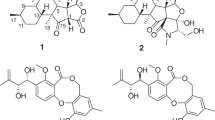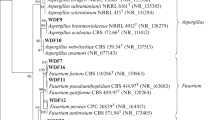Abstract
An endophytic fungus Salicorn 19 was isolated from Salicornia bigelovii Torr. and identified as Fusarium tricinctum using a combination of translation elongation factor 1 alpha (EF-1α) and β-tubulin (β-TUB) gene sequence analysis. A bioassay-guided fractionation led to a new sesquiterpenoid ether with unique skeleton fusartricin (1), and two known compounds fusarielin B (2) and enniatin B (3) from the culture of Salicorn 19. Their chemical structures were elucidated based on ESI–MS and NMR analysis, as well as a comparison with the literature data. Antimicrobial experiments revealed that compounds 1 exhibited significant antimicrobial activities against E. aerogenes, M. tetragenu and C. albicans with the MIC values 19, 19 and 19 µM, respectively, and compound 2 showed a broader spectrum antimicrobial activity against M. smegmati, B. subtilis, M. phlei and E.coli with MIC values 19, 19, 10 and 10 µM, respectively, and compound 3 displayed powerful antimicrobial activities toward B. subtilis, E. aerogenes and M. tetragenus with MIC values 13, 13 and 6 µM.



Similar content being viewed by others
References
Wilson D (1995) Endophyte: the evolution of a term, and clarification of its use and definition. Oikos 73:274–276
Zhao J, Shan T, Mou Y, Zhou L (2011) Plant-derived bioactive compounds produced by endophytic fungi. Mini Rev Med Chem 11(2):159–168
Kusari S, Spiteller M (2011) Are we ready for industrial production of bioactive plant secondary metabolites utilizing endophytes? Nat Prod Rep 28(7):1203–1207. doi:10.1039/C1NP00030F
Arnold A, Maynard Z, Gilbert G, Coley P, Kursar T (2000) Are tropical fungal endophytes hyperdiverse? Ecol Lett 3(4):267–274
Strobel G, Daisy B, Castillo U, Harper J (2004) Natural products from endophytic microorganisms. J Nat Prod 67(2):257–268
Tayung K, Barik B, Jha D, Deka D (2011) Identification and characterization of antimicrobial metabolite from an endophytic fungus, Fusarium solani isolated from bark of Himalayan yew. Mycosphere 2(3):203–213
Zhao Y, Wang X, Wang H, Liu T, Xin Z (2014) Two new noroleanane-type triterpene saponins from the methanol extract of Salicornia herbacea. Food Chem 151:101–109
Wang X, Zhang M, Zhao Y, Wang H, Liu T, Xin Z (2013) Pentadecyl ferulate, a potent antioxidant and antiproliferative agent from the halophyte Salicornia herbacea. Food Chem 141(3):2066–2074
Guo LD, Huang GR, Wang Y, He WH, Zheng WH, Hyde KD (2003) Molecular identification of white morphotype strains of endophytic fungi from Pinus tabulaeformis. Mycol Res 107(6):680–688
O’Donnell K, Kistler HC, Tacke BK, Casper HH (2000) Gene genealogies reveal global phylogeographic structure and reproductive isolation among lineages of Fusarium graminearum, the fungus causing wheat scab. Proc Natl Acad Sci USA 97(14):7905–7910
Knutsen A, Torp M, Holst-Jensen A (2004) Phylogenetic analyses of the Fusarium poae, Fusarium sporotrichioides and Fusarium langsethiae species complex based on partial sequences of the translation elongation factor-1 alpha gene. Int J Food Microbiol 95(3):287–295
O’Donnell K, Cigelnik E (1997) Two divergent intragenomic rDNA ITS2 types within a monophyletic lineage of the fungus Fusarium are nonorthologous. Mol Phylogenet Evol 7(1):103–116
Yli-Mattila T, Paavanen-Huhtala S, Bulat SA, Alekhina IA, Nirenberg HI (2002) Molecular, morphological and phylogenetic analysis of the Fusarium avenaceum/F. arthrosporioides/F. tricinctum species complex—a polyphasic approach. Mycol Res 106(6):655–669
Harrow SA, Farrokhi-Nejad R, Pitman AR, Scott IA, Bentley A, Hide C, Cromey MG (2010) Characterisation of New Zealand Fusarium populations using a polyphasic approach differentiates the F. avenaceum/F. acuminatum/F. tricinctum species complex in cereal and grassland systems. Fungal Biol 114(4):293–311
Tamura K, Peterson D, Peterson N, Stecher G, Nei M, Kumar S (2011) MEGA5: molecular evolutionary genetics analysis using maximum likelihood, evolutionary distance, and maximum parsimony methods. Mol Biol Evol 28(10):2731–2739
Gomez S, Cosson C, Deschamps A (1997) Evidence for a bacteriocin-like substance produced by a new strain of Streptococcus sp., inhibitory to Gram-positive food-borne pathogens. Res Microbiol 148(9):757–766
Kobayashi H, Sunaga R, Furihata K, Morisaki N, Iwasaki S (1995) Isolation and structures of an antifungal antibiotic, fusarielin A, and related compounds produced by a Fusarium sp. J Antibiot (Tokyo) 48(1):42–52
Blais L, ApSimon J, Blackwell B, Greenhalgh R, Miller J (1992) Isolation and characterization of enniatins from Fusarium avenaceum DAOM 196490. Can J Chem 70(5):1281–1287
Sørensen JL, Akk E, Thrane U, Giese H, Sondergaard TE (2013) Production of fusarielins by Fusarium. Int J Food Microbiol 160(3):206–211
Summerell BA, Leslie JF (2011) Fifty years of Fusarium: how could nine species have ever been enough? Fungal Divers 50(1):135–144
Geiser DM, del Mar Jiménez-Gasco M, Kang S, Makalowska I, Veeraraghavan N, Ward TJ, Zhang N, Kuldau GA, O’Donnell K (2004) FUSARIUM-ID v. 1.0: a DNA sequence database for identifying Fusarium. In: Mulè G, Bailey JA, Cooke BM, Logrieco A (eds) Molecular diversity and PCR-detection of toxigenic Fusarium species and ochratoxigenic fungi. Springer, Netherlands, pp 473–479
Gomez E, Riboldi M, Galan A, Medrano JV, Rubio MC, Martinez MC, Martinez-Jabaloyas JM, Pellicer A, Simon C, Riboldi M, Medrano JV, Marques-Mari AI, Gomez E, Poo ME, Aguilar C, Pellicer A, Gil Salom M, Simon C, Kim YY, Ku SY, Oh SK, Kim SH, Moon SY, Choi YM, Pellestor F, Monzo C, Nadal L, De Vos J, Hamamah S, Liang W, Cao Y, Zhao R, Lu C, Carlomagno G, van Bragt MPA, Korver CM, Repping S, de Rooij DG, van Pelt AMM, Sedlackova M, Zakova J, Hampl A, Dvorak P, Yachimovich-Cohen N, Even-Ram S, Shufaro Y, Rachmilewitz J, Reubinoff BE, Akhlaghi AA, Eslaminejad MRB, Falahi F, Nazarian H, Omani Samani R, Shahverdi A, Tavakolifar F, Pirouz M, Baharvand H, Davenport K, Dutton M, Zhao H, Li Y, Haifeng J, Xie L, Chuang L, Feng J, Yaning L, Guowu Y, Yi L, Jun W, Xiaohong W (2010) PostersStem Cells. Hum Reprod 25(suppl 1):i335–i339. doi:10.1093/humrep/de.25.s1.570
Nalim F, Elmer W, McGovern R, Geiser D (2009) Multilocus phylogenetic diversity of Fusarium avenaceum pathogenic on lisianthus. Phytopathology 99(4):462–468
Sutton J (1982) Epidemiology of wheat head blight and maize ear rot caused by Fusarium graminearum. Can J Plant Pathol 4(2):195–209
Campos FF, Johann S, Cota BB, Alves TMA, Rosa LH, Caligiorne RB, Cisalpino PS, Rosa CA, Zani CL (2011) Antifungal activity of trichothecenes from Fusarium sp. against clinical isolates of Paracoccidioides brasiliensis. Mycoses 54(4):e122–e129
Solfrizzo M, Visconti A, Savard M, Blackwell B, Nelson P (1994) Isolation and characterization of new chlamydosporol related metabolites of Fusarium chlamydosporum and Fusarium tricinctum. Mycopathologia 127(2):95–101
Burmeister H, Grove M, Kwolek W (1980) Moniliformin and butenolide: effect on mice of high-level, long-term oral intake. Appl Environ Microbiol 40(6):1142
Logrieco A, Rizzo A, Ferracane R, Ritieni A (2002) Occurrence of beauvericin and enniatins in wheat affected by Fusarium avenaceum head blight. Appl Environ Microbiol 68(1):82–85
Tejesvi M, Segura D, Schnorr K, Sandvang D, Mattila S, Olsen P, Neve S, Kruse T, Kristensen H, Pirttilä A (2013) An antimicrobial peptide from endophytic Fusarium tricinctum of Rhododendron tomentosum Harmaja. Fungal Divers 60(1):153–159
Visconti A, Solfrizzo M (1994) Isolation, characterization and biological activity of visoltricin, a novel metabolite of Fusarium tricinctum. J Agric Food Chem 42(1):195–199
Takagi M, Motohashi K, Nagai A, Izumikawa M, Tanaka M, Fuse S, Doi T, Iwase K, Kawaguchi K, Nagata K (2010) Anti-influenza virus compound from Streptomyces sp. RI18. Org Lett 12(20):4664–4666
Zafrir Ilan E, Torres MR, Prudhomme J, Le Roch K, Jensen PR, Fenical W (2013) Farnesides A and B, sesquiterpenoid nucleoside ethers from a marine-derived Streptomyces sp., strain CNT-372 from Fiji. J Nat Prod 76(9):1815–1818
Gai Y, Zhao LL, Hu CQ, Zhang HP (2007) Fusarielin E, a new antifungal antibiotic from Fusarium sp. Chin Chem Lett 18(8):954–956
Nenkep V, Yun K, Zhang D, Choi HD, Kang JS, Son BW (2010) Induced production of bromomethylchlamydosporols A and B from the marine-derived fungus Fusarium tricinctum. J Nat Prod 73(12):2061–2063
Nguyen HP, Zhang D, Lee U, Kang JS, Choi HD, Son BW (2007) Dehydroxychlorofusarielin B, an antibacterial polyoxygenated decalin derivative from the marine-derived fungus Aspergillus sp. J Nat Prod 70(7):1188–1190
Kumagai H, Someno T, Dobashi K, Isshiki K, Ishizuka M, Ikeda D (2004) ICM0301s, new angiogenesis inhibitors from Aspergillus sp. F-1491. I. Taxonomy, fermentation, isolation and biological activities. J Antibiot (Tokyo) 57(2):97–103
Someno T, Kumagai H, Ohba S, Amemiya M, Naganawa H, Ishizuka M, Ikeda D (2004) ICM0301s, new angiogenesis inhibitors from Aspergillus sp. F-1491. II. Physico-chemical properties and structure elucidation. J Antibiot (Tokyo) 57(2):104–109
Ivanova L, Egge-Jacobsen W, Solhaug A, Thoen E, Fæste C (2012) Lysosomes as a possible target of enniatin B-induced toxicity in Caco-2 cells. Chem Res Toxicol 25(8):1662–1674
Sy-Cordero AA, Pearce CJ, Oberlies NH (2012) Revisiting the enniatins: a review of their isolation, biosynthesis, structure determination and biological activities. J Antibiot (Tokyo) 65(11):541–549
Cuomo V, Randazzo A, Meca G, Moretti A, Cascone A, Eriksson O, Novellino E, Ritieni A (2013) Production of enniatins A, A1, B, B1, B4, J1 by Fusarium tricinctum in solid corn culture: structural analysis and effects on mitochondrial respiration. Food Chem 140(4):784–793
Tomoda H, Huang X, Cao J, Nishida H, Nagao R, Okuda S, Tanaka H, Omura S, Arai H, Inoue K (1992) Inhibition of acyl-CoA: cholesterol acyltransferase activity by cyclodepsipeptide antibiotics. J Antibiot 45(10):1626–1632
Jestoi M (2008) Emerging fusarium-mycotoxins fusaproliferin, beauvericin, enniatins, and moniliformin: a review. Crit Rev Food Sci Nutr 48(1):21–49
Acknowledgments
This work was financially supported by the Chinese National Natural Science Fund (No. 31071586), the Fundamental Research Funds for the Central Universities (KYZ201118), the project funded by special funds of agro-product quality safety risk assessment of Ministry of Agriculture of the People's Republic of China and a project funded by the Priority Academic Program Development of Jiangsu Higher Education Institutions.
Conflict of interest
None.
Compliance with Ethics Requirements
This article does not contain any studies with human or animal subjects.
Author information
Authors and Affiliations
Corresponding author
Electronic supplementary material
Below is the link to the electronic supplementary material.
Rights and permissions
About this article
Cite this article
Zhang, J., Liu, D., Wang, H. et al. Fusartricin, a sesquiterpenoid ether produced by an endophytic fungus Fusarium tricinctum Salicorn 19. Eur Food Res Technol 240, 805–814 (2015). https://doi.org/10.1007/s00217-014-2386-6
Received:
Revised:
Accepted:
Published:
Issue Date:
DOI: https://doi.org/10.1007/s00217-014-2386-6




